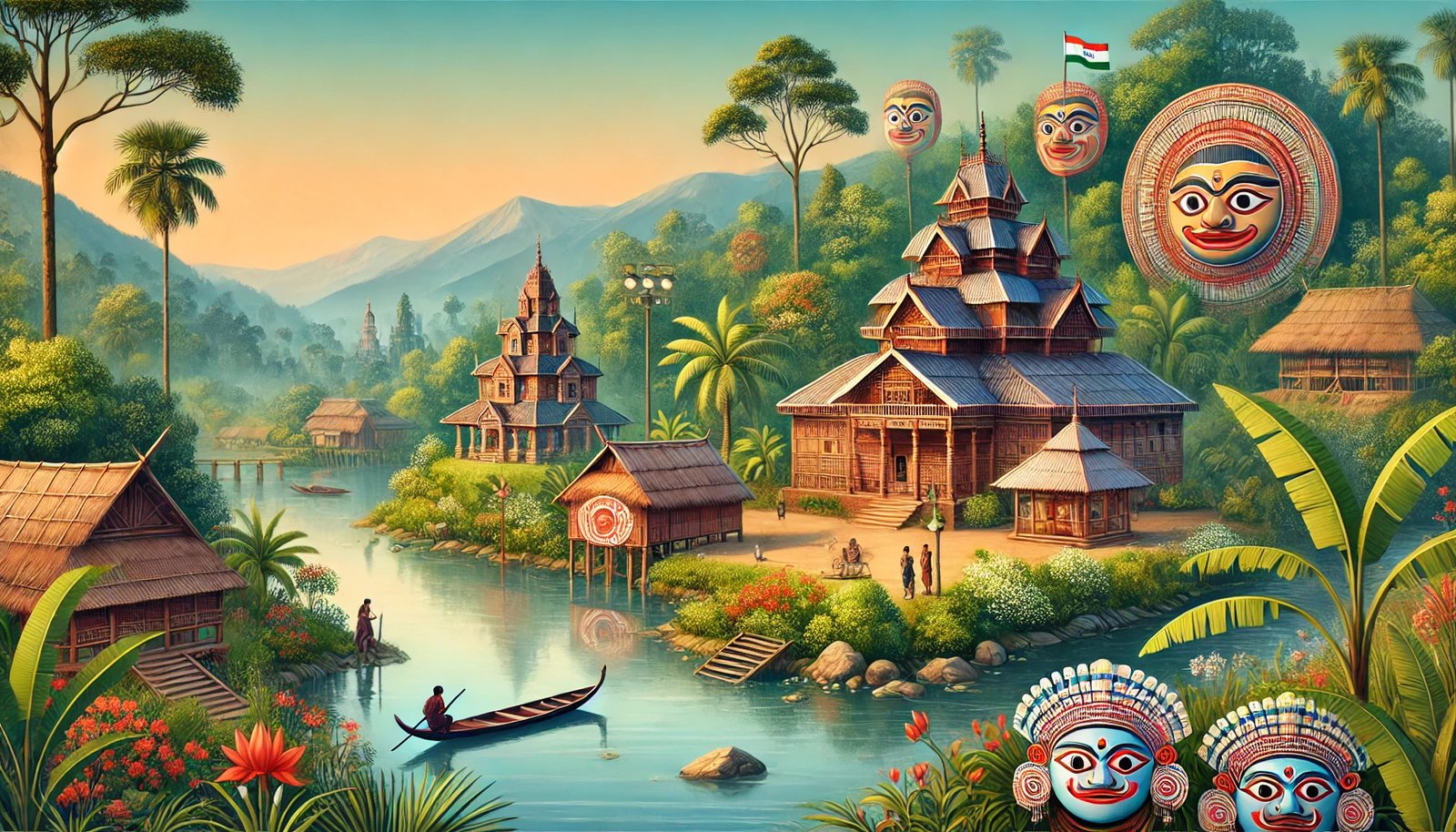Introduction
Satras and Namghars, the spiritual and cultural epicenters of Assam, serve as more than just places of worship. Established by visionary saints like Sankardev, Madhabdev, and Damodardev in the 15th century, these institutions are repositories of Assamese culture, art, and religion. They continue to play a pivotal role in the socio-cultural landscape of Assam and neighboring regions.
Satras: Epicenters of Assamese Culture
Satras are monastic institutions that have been the bedrock of the Neo-Vaishnavite movement in Assam. Founded by the revered saint Sankardev and his disciples, these monasteries proliferated across Assam and West Bengal, with the first Satra established in Majuli. Today, 862 Satras exist, although only 22 remain in Majuli due to flood and erosion challenges. The Assam Satra Mahasabha, an umbrella organization, coordinates activities among these Satras.
Satras typically feature a large prayer hall facing a simple shrine, surrounded by dormitories and bathing tanks for monks. These monasteries also provide guest accommodations, allowing devotees to engage in worship and witness traditional bhaona performances. The young celibate monks, known as bhakats, are skilled artisans who create masks, musical instruments, hand-fans, and door frames.

Notable Satras:
- Auniati Satra
- Founder: Niranjan Pathakdeva
- Highlights: Famous for Paalnaam and Apsara dances, extensive collection of ancient artifacts, Assamese utensils, jewelry, and handicrafts.
- Dakhinpat Satra
- Founder: Banamalidev
- Highlights: Known for Raasleela festival, attracting thousands of devotees annually.
- Garamur Satra
- Founder: Lakshmikantadeva
- Highlights: Traditional Raasleela performances and preservation of ancient weapons, including cannons.
- Kamalabari Satra
- Founder: Bedulapadma Ata
- Highlights: Center of art, culture, literature, and classical studies. Notable for boat making. Uttar Kamalabari Satra has showcased Satria Art across India and abroad.
- Bengenaati Satra
- Founder: Muraridev
- Highlights: Storehouse of cultural antiques and advanced center of performing arts.
- Shamaguri Satra
- Highlights: Best visited during the Raas festival in November. Famous for Paalnaam and Apsara dance performances and ancient Assamese artifacts.

Namghars: Hubs of Community and Spiritual Life
Namghars, or community prayer halls, are integral to Assamese villages, towns, and cities. They serve as egalitarian platforms for worship and discussion, welcoming all devotees regardless of background. Established by Srimanta Sankardeva and his disciple Madhavdeva, Namghars continue to uphold the religious and spiritual traditions they initiated.
A typical Namghar is a rectangular structure with a gabled roof, constructed from bamboo and timber, although modern Namghars are often made of concrete. The western facade is typically apsidal, and the building features a veranda. The Namghar also includes a separate room called the manikut, or bhajghar, which houses important religious artifacts.
Namghars function as self-governing institutions, exemplifying social sustainability. They have well-defined revenue systems, track funds meticulously, and assign specific roles to ensure smooth operations. These prayer halls not only facilitate worship but also foster community decision-making and cultural preservation.
Key Aspects of Namghars:
- Community Prayer and Meeting Hall: Serving as a common platform for devotees, Namghars allow for inclusive worship and community gatherings.
- Institution of Self-Governance: Namghars operate with clear governance structures, ensuring participation in decision-making processes.
- Cultural Milieu: Namghars play a crucial role in shaping the cultural environment of their surrounding areas.
- Revenue and Fund Management: They have established methods for revenue collection and fund management to support their activities.
Bathou Thansali: Temples of the Bodo-Kachari Tribes
Bathou Thansali temples are significant religious sites for the Bodo or Kachari tribes, followers of the Bathou religion. ‘Bathou’ signifies the five principles of air, fire, earth, water, and ether, believed to be created by the chief deity Bathoubwrai.
The construction of Bathou Thansali temples involves five distinct stages. Traditionally made from bamboo and timber, modern temples often use concrete. These temples feature vibrant color combinations, primarily white, red, and yellow, with occasional use of blue and green for added appeal. The design includes a rectilinear plan and twisted roof structures, symbolizing various cultural and religious aspects.
Fig 4: The illustration of a Bathou Thansali Temple
Conclusion
Satras and Namghars are not only spiritual sanctuaries but also vital cultural institutions preserving Assam’s rich heritage. They embody a unique blend of religious devotion, community governance, and cultural artistry, reflecting the enduring legacy of Assam’s spiritual leaders and their vision of an inclusive, culturally vibrant society.
Bibliography
- Assam Satra Mahasabha (Official Website)
- Publications on Neo-Vaishnavism in Assam
- Historical records and cultural artifacts from various Satras
- Personal interviews with Satradhikars and Namghar administrators
